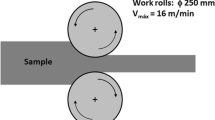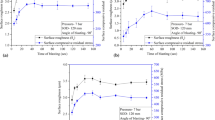Abstract
Abrasion of a metallic surface to improve bonding during strain-gage installation is generally thought to produce negligible effect on the measurement of residual stresses by blind hole drilling. However, residual stresses induced by surface abrasion may affect residual-stress measurements in shallow subsurface layers of residual-stress fields produced by processes such as grinding and shot peening.
The residual-stress and cold-work distributions produced by four methods of abrasive surface preparation and etching were studied by X-ray diffraction in fully annealed AISI 1018 steel. The surface residual stresses produced by abrasion ranged from tension to compression with magnitudes as high as 80 percent of the yield strength. Cold work was induced to depths of 20 to 60 μm. Etching produced low magnitude surface stresses and negligible cold work.
Similar content being viewed by others
References
“Standard Method for Determining Residual Stresses by the Hole-Drilling Strain-Gage Method,”Annual Book of ASTM Standards, ASTM, Philadelphia,3.01 (E837),782–787 (1984).
Niku-Lari, A., Lu, J. andFlavenot, J.F., “Measurement of Residual-Stress Distribution by the Incremental Hole-Drilling Method,”Experimental Mechanics,25 (2),175–185 (June 1985).
Flaman, M.T. andManning, B.H., “Determination of Residual-Stress Variation with Depth by the Hole-Drilling Method,”Experimental Mechanics,25 (3),205–207 (Sept. 1985).
SEM Residual Stress Measurement Committee, “Bulk-Zero Stress Standard — AISI 1018 Carbon-Steel Specimens, Round Robin Phase I,” secretary J.J. Yavelak,Experimental Techniques,9 (4),38–41 (April 1985).
Alloy Digest, AISI 1018 Steel Spec. Sheet CS-56, Eng. Alloy Dig. (March 1985).
“Residual Stress Measurement by X-Ray Diffraction,”ed. M.E. Hilley, SAE J784a, Soc. Auto. Eng., Warrendale, PA, 19 (1971).
Prevey, P.S., “The Use of Pearson VII Distribution Functions in X-Ray Diffraction Residual Stress Measurement,”Advances in X-Ray Analysis, Plenum Press, NY,29,103–112 (1986).
Prevey, P.S., “A Method of Determining the Elastic Properties of Alloys in Selected Crystallographic Directions for X-Ray Diffraction Residual Stress Measurement,”Advances in X-Ray Analysis, Plenum Press, NY,20,345–354 (1977).
“Residual Stress Measurement by X-Ray Diffraction,”ed. M.E. Hilley, S.A.E. J784a, Soc. Auto. Eng., Warrendale, PA 61 (1971).
Moore, M.C. and Evans, W.P., “Mathematical Corrections for Stress in Removed Layers in X-Ray Diffraction Residual Stress Analysis,” SAE Trans.,66 (1958).
“Standard Method for Verifying the Alignment of X-Ray Diffraction Instrumentation for Residual Stress Measurement,” Annual Book of ASTM Standards, ASTM, Philadelphia, PA,3.01 (E915), 809–812 (1984).
Prevey, P.S., “Surface Residual Stress Distributions in As-Bent Inconel 600 U-Bend and Incoloy 800 90-Degree Bend Tubing Samples,” Workshop Proc.: U-Bend Cracking in Steam Generators, Elec. Power Res. Inst., Palo Alto, CA, 12–3 to 12–19 (1981).
“Residual Stress Measurement by X-Ray Diffraction,”ed. M.E. Hilley, SAE J784a, Soc. Auto. Eng., Warrendale, PA, 20 (1971).
Author information
Authors and Affiliations
Rights and permissions
About this article
Cite this article
Prevey, P.S. Residual-stress distributions produced by strain-gage surface preparation. Experimental Mechanics 28, 92–97 (1988). https://doi.org/10.1007/BF02329002
Received:
Revised:
Issue Date:
DOI: https://doi.org/10.1007/BF02329002




